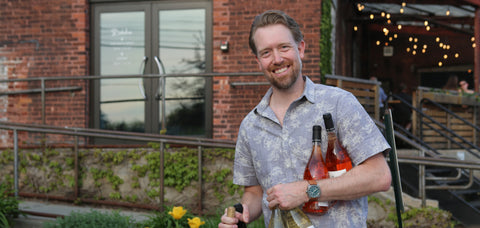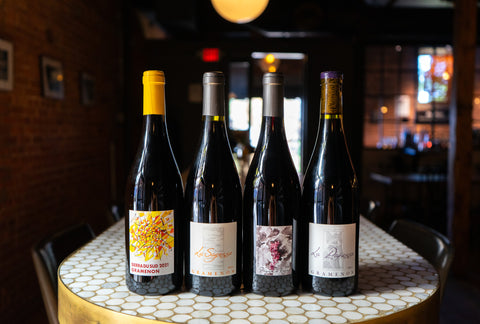Roberto Santana, Alfonso Torrente, Laura Ramos, and José Martínez met while studying enology in Alicante. Since graduating, they’ve crafted some of the most sought-after wines in the country. Named Envínate, they produce minuscule quantities of Atlantic-influenced wines from intriguing parcels around the country, pushing the envelope with every new vintage.
No Money, No Problem
When they graduated in 2005, they had no money, no family connections, and no inherited vineyards. That didn’t stop them. They scraped together cash working odd jobs at wineries and vineyards, farming out their expertise to more established estates. In 2008, the hustle finally paid off when they purchased their first parcel of vines in Ribeira Sacra. Their first vintage under the current label followed shortly after in 2011. Today they control 45 hectares of hard-to-reach, extremely old vines (some up to 300 years old) between Tenerife in the Canary Islands, and Ribeira Sacra, Extremadura, and Almansa in mainland Spain.
A Common Code
Each member of the group works in a different corner of Spain, but they make all their farming winemaking decisions as a collective. Over the years they’ve developed a code, a shared language that unites them over long distances. Their three tenets are:
- The personality of a wine comes from the soil. Different soils will give different personalities. And the most clear transmissions come from soils teeming with life, those that are farmed free of chemicals.
- The character of a wine comes from the peculiarities of each vintage, and each year should vary. After all, they’re not trying to make Coca-Cola.
- The soul of a wine comes from the people who work the vines. If workers — some of them octogenarians who have tended these vines for their entire lives — are happy, it will show up in the grapes.
In the vineyards, they forgo synthetic chemicals and pick by hand. In Tenerife and Ribeira Sacra, that work is downright treacherous — their vines cling to rocky 45-degree slopes held together with prayers and fastidiously maintained retaining walls. In the cellar, grapes are crushed by foot, fermented with native yeasts, and raised in old neutral barrels or concrete. The quartet adds a tiny amount of sulfur at bottling, when necessary.
In Context, Radicals
However common sense their methods seem today (in a world where natural winemaking has a giants toehold in the mainstream) in the context of Spain’s winemaking history and culture, Envínate is a band of radicals.
Not even 50 years ago, Spain was ruled by a fascist dictator hellbent on stamping out diversity and dissent, and traditional wine along with it. Millions of people fled, and many didn’t make it out. Franco popularized massive co-ops that churned out bulk table wine meant for profit, not pleasure. As a result, Spain lost its standing as a place to find high-quality wine. It wasn’t until he died in 1975 and the country returned to a more democratic structure that quality began to take priority over quantity, and small producers got the chance to get back in the game in a real way.
Even then, fashion ruled the game. Rioja style wines dominated, then gave way to the full-bodied, heavily extracted styles favored by Robert Parker, and today natural wine is elbowing its way into the spotlight.
Is Envínate natural? Decidedly yes, with their focus on native yeast fermentation and no-chemical farming (purists might trash that characterization based on their very practical, very minimal use of sulfur), but they’re not in it for the hype. This quartet pursues brave, honest representations of unusual terroirs. Easily marketed carbon copies be damned. They only traffic in originals, and each vintage is a new story.
Wines of Cosmic Beauty
That’s why these wines sell out the minute they hit shelves. People who have had the opportunity to taste them remember how they are cosmically marked with the vivid fingerprint of a far-off place. People who have the patience to cellar them can taste talk about how the wines seem alive, singular, uncanny in their crisp, clear portraits of place.
The high-toned, saline Benje Blanco comes from an untrained parcel of Listan Blanco on Tenerife, with 25% macerated on its skins then raised for 8 months in 60% concrete and 40% old French barriques on the fine lees without battonage.
Then there’s the Vidueño de Santiago del Teide from a tiny parcel co-planted to ancient, untrained Listan Blanco and Listan Prieto. Destemmed and macerated together, then transferred to three old French barriques to age for 8 months on the fine lees, it’s volcanic and vibrant, with smoky strawberry, fine tannins, and refreshing acidity.
Their Lousas Parcela Camiño Novo from a single parcel of Mencia and Garnacha Tintorera in their Ribeira Sacra holdings is ethereal and focused with floral, herbal, and spice aromatics. It comes from 70-year-old vines and is fermented 100% whole cluster and raised for 11 months in large used oak barrels.
If you see these bottles on the shelf, drop everything. Run to them. Secure as many as you’re allowed to, and drop them in the cellar for a few years. Like a good Burgundy, it's a mistake to open Envínate wines too soon. Trust us, you'll be rewarded for your patience.



